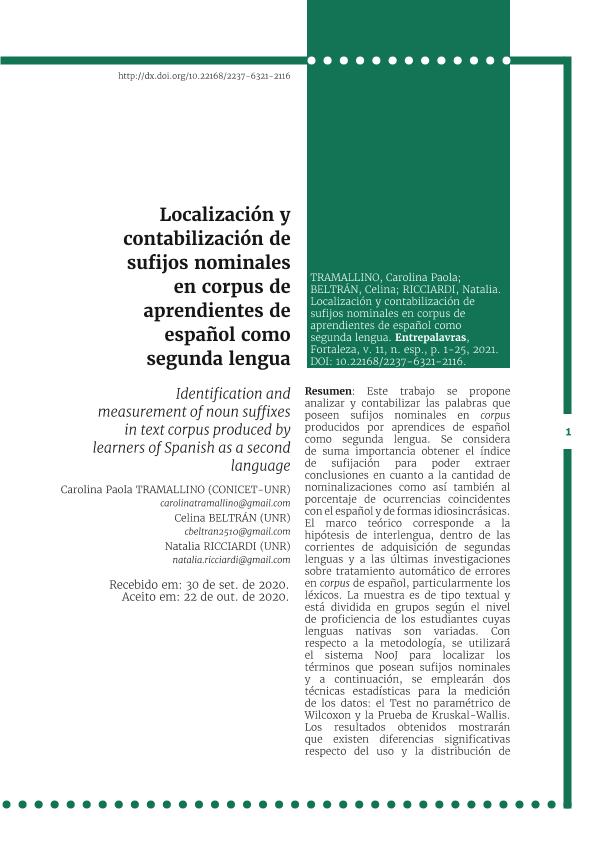Artículo
Este trabajo se propone analizar y contabilizar las palabras que poseen sufijos nominales en corpus producidos por aprendices de español como segunda lengua. Se considera de suma importancia obtener el índice de sufijación para poder extraer conclusiones en cuanto a la cantidad de nominalizaciones como así también al porcentaje de ocurrencias coincidentes con el español y de formas idiosincrásicas. El marco teórico corresponde a la hipótesis de interlengua, dentro de las corrientes de adquisición de segundas lenguas y a las últimas investigaciones sobre tratamiento automático de errores en corpus de español, particularmente los léxicos. La muestra es de tipo textual y está dividida en grupos según el nivel de proficiencia de los estudiantes cuyas lenguas nativas son variadas. Con respecto a la metodología, se utilizará el sistema NooJ para localizar los términos que posean sufijos nominales y a continuación, se emplearán dos técnicas estadísticas para la medición de los datos: el Test no paramétrico de Wilcoxon y la Prueba de Kruskal-Wallis. Los resultados obtenidos mostrarán que existen diferencias significativas respecto del uso y la distribución de sufijos nominales pertenecientes al español entre los corpus que no comparten un mismo nivel de instrucción. En efecto, se hallará un aumento significativo de sufijos nominales coincidentes en la muestra de nivel intermedio con respecto al nivel inicial. Sin embargo, los corpus analizados no presentarán diferencias considerables en otros dos casos: sufijos existentes en español pero no combinables con las bases y sufijos inexistentes en dicha lengua. This study aims to analyze and to record the number of words with noun suffixes in a corpus produced by learners of Spanish as second language. Obtaining the suffix index is of utmost importance to draw conclusions about both, the number of nominalizations and the percentage of occurrences coincident with Spanish suffixes as well as idiosyncratic forms. The study is based on the theoretical framework of the interlanguage hypothesis within the theories of second language acquisition and the latest research on automatic handling of errors in Spanish corpus, particularly lexicons. The text corpus is divided in groups according to the proficiency level of the students, who have different native languages. Regarding the methodology, the Nooj system will be used so as to identify the terms that have noun suffixes, and then two different statistical techniques will be implemented to measure the data: the nonparametric test of Wicoxon for independent samples and the non-parametric test of Kruskal-Wallis. The obtained results will show substantial differences in the use and distribution of Spanish noun suffixes among the corpus that do not share the same level of proficiency. Indeed, a significant increase in matching nominal suffixes will be found in the intermediate level sample as compared to the initial level. However, the examined corpus will not show considerable differences in two other cases: existing suffixes in Spanish not combinable with bases and non-existent suffixes.
Localización y contabilización de sufijos nominales en corpus de aprendientes de español como segunda lengua
Título:
Identification and measurement of noun suffixes in text corpus produced by learners of Spanish as a second language
Fecha de publicación:
06/2021
Editorial:
Universidade Federal do Ceará
Revista:
Entrepalavras
ISSN:
2237-6321
Idioma:
Español
Tipo de recurso:
Artículo publicado
Clasificación temática:
Resumen
Palabras clave:
SUFIJOS NOMINALES
,
CORPUS ESPAÑOL
,
SEGUNDA LENGUA
,
MEDICIÓN
Archivos asociados
Licencia
Identificadores
Colecciones
Articulos(CCT - ROSARIO)
Articulos de CTRO.CIENTIFICO TECNOL.CONICET - ROSARIO
Articulos de CTRO.CIENTIFICO TECNOL.CONICET - ROSARIO
Citación
Tramallino, Carolina Paola; Beltran, Celina; Ricciardi, Natalia; Localización y contabilización de sufijos nominales en corpus de aprendientes de español como segunda lengua; Universidade Federal do Ceará; Entrepalavras; 11; 10; 6-2021; 1-25
Compartir
Altmétricas




